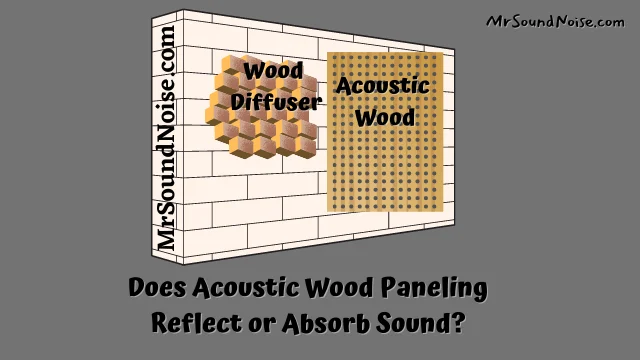
You can’t understand whether acoustic wood paneling can stop sound or not. You also have confusion about the soundproofing activity of the wood panel.
You have plans to set up soundproofing accessories in your home place. If this type of panel can stop the noise transfer, then it will be better for you.
This is why you are finding the actual information and the answer to this question: is wood material soundproof or not?
I think, now, you are at the right place where you can get the answer to what you are finding on the internet.
Normally, wood is not suitable for absorbing sound and it can reflect some unwanted noise.
Wait…
Don’t skip…
I have not completed the full answer to this question. There are many types of acoustic elements that are made of wood.
So you should continue reading if you know about the sound-reducing accessories that are made from these panels.
So, continue reading…
Does Wood Paneling Absorb or Reflect Sound?
Solid wood has not the best quality to stop maximum sound waves. The Noise Reduction Coefficient (NRC) of normal wood panels is around 0.05-0.16.
Besides, the NRC of this material depends on the various structural wood designs. In that case, the NRC may vary according to the material.
If you make a diffuser or use this type of panel with other acoustic material, then you can reduce maximum noise.
You can increase the acoustic properties of wood by redesigning the physical structure. Now, many companies are creating acoustic-type wooden material for implementation in soundproofing activities.
So, now I will share the character of this panel in sound absorption, reduction, diffusion. If you read this information, you can get an idea about the noise-reducing activity of this board.
Is a Wood Panel a Good Sound Insulator?
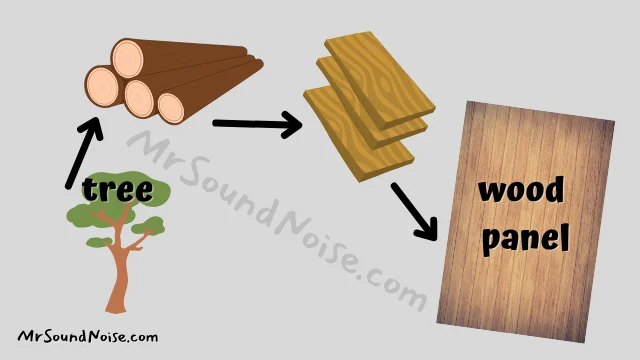
Solid wood panel boards don’t work well as sound insulation. But you can increase the sound-absorbing performance of this panel.
How?
By creating a porous design in this panel, It can absorb some noise frequency. By applying this theory, many industries are producing acoustic wood for soundproofing implementation.
Porous design means creating lots of small holes or irregular shapes on the surface of this panel. An example of this type of irregular surface is the wood diffuser which is growing popular for applying in noise-reducing activities.
So sound-absorbing wood panels also create a positive role in reducing noise.
Performance of Acoustic Wood Panels
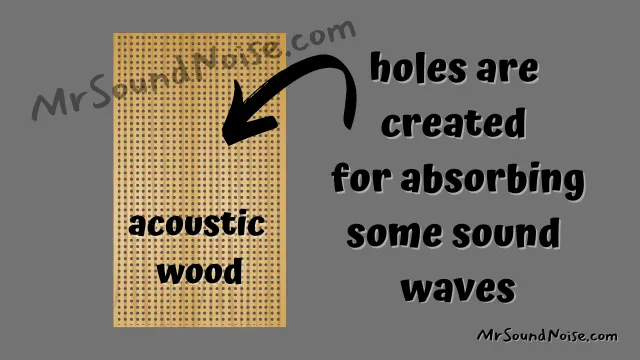
Normally wood doesn’t absorb unwanted sounds but you may change this character by applying some changes.
If you create lots of small holes, porous nature, or slots cut in the surface of this panel, that perforated wood panel absorbs some noise.
Because porous design also improves the absorbing capability of any material. See the image as an example and you will get this type of panel in the specific market.
N.B: The better sound-absorbing materials are acoustic foams (soft and porous materials according to structure) which are not wooden materials.
When the sound waves fall on the surface of porous design, these waves are divided into small waves (fragmented) and finally lose their energy. This is how a porous design of any panel may reduce some noise frequencies.
Some low-energy sound waves are absorbed by this panel. If you are trying to remove low-frequency noise, you can try this type of panel.
Performance of Wood in Noise Reflection
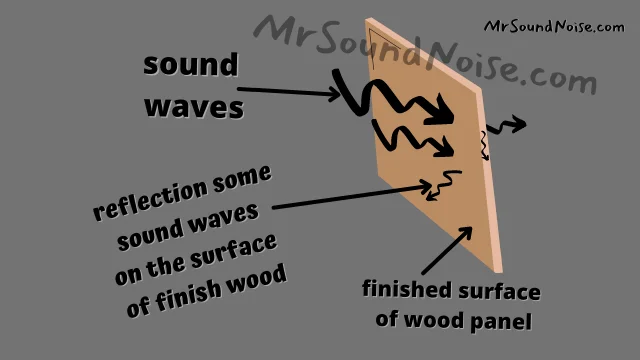
Some sound waves are reflected in the finished surface of the wood panel. If the smoothness of the surface is high, the reflected capability of that panel will be high.
It depends on the quality and smooth surface of the specific panel. In the image, you will see that some sound waves have fallen to the finished surface of the wood board.
Some sound waves reflect some flow in the board and some waves pass that board.
You can reduce some echo waves that are created inside the room. The echo is the reflected sound that is automatically created while talking in the room.
N.B: If you want to insulate/soundproof the room you should try other non-wooden and high-performance acoustic materials. Such as:
- Mass loaded vinyl (noise barriers)
- Acoustic underlayments (has acoustical properties)
Performance of Wood Diffuser
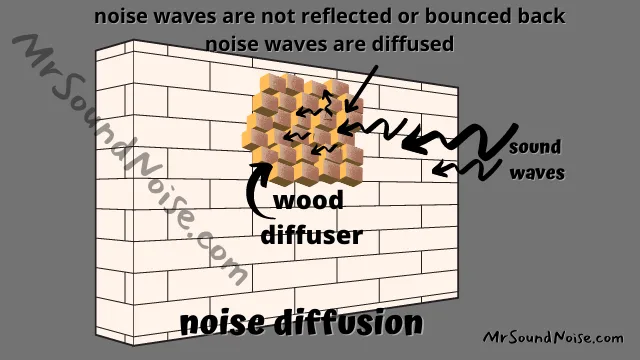
Many people also know about noise diffusion. Now, I am telling the meaning of this term in an easy way.
When sound frequencies are struck on the irregular surface, these frequencies are scattered or diffused and lose their energy for movement. This is why irregular wooden surfaces are also effective to weaken some noise waves.
When noise is created Inside the building room, some noise bounced back and created a loud sound. This type of noise is also called echo.
Nowadays, most people are trying to remove this echo and you also need to solve this problem. This is why people use various types of diffusers for solving that issue.
The wooden diffuser is also effective to reduce these bounced back waves. In the image, you can see that noise waves are diffused by this diffuser.
N.B: Wood diffuser and other non-wooden acoustic materials are used for wall soundproofing.
Best or Reliable Wood for Soundproofing/Absorption
Though solid wood is not good soundproof, two types of wood material are better than other normal panels. A short description of these two types is given below.
1. Wooden Cork Sheets
Cork sheets are made from the bark of the cork oak tree. It has some elastic characteristics. This type of sheet includes fatty acids.
For the elastic property and including fatty acids, it can remove some noise frequency. It is also durable and fire-resistant (up to specific temperatures).
The material of the cork includes anti-microbial elements. This cork is environmentally friendly and you can use it in your room.
2. Medium Density Fiberboard
The other name of this board is MDF. This board is made from chips and shavings. Specified resign and wax are mixed with this MDF board.
All the combinations of these materials and some acoustic characteristics are found on this board. This is why it can remove some sound frequencies.
Some people are also using this type of engineered board for their soundproofing implementation.
N.B: If you don’t like wooden panels, you can use drywall as the alternative to MDF. Drywall is one kind of hardboard panel that is also used in the wall and ceiling surface. Gypsum material is included in that board. This is why it removes sound waves like MDF. If you use the resilient channel with it, you can also reduce more sound waves from the drywall setting. Besides, you can use this type of resilient channel with MDF too.
3. Sound Diffuser/Acoustic Diffuser/Wood Diffuser
You already know about the term wood diffuser. To weaken some sound, you should set up this type of acoustic diffuser on the wall surface of your room.
If you don’t get it from your local market, you can create it easily with the help of a carpenter. You should assure him that the design of that diffuser will be better than plywood.
4. Fiberboard/Oriented Strand Board/Hardboard
This type of board is created from aspen wood chips or strands. Using resin and wax on this board works to remove some noise. The characteristic of the oriented strand board (OSB) panel is like drywall.
This board is created by following an engineered design so that it can be used in reducing sound frequencies. If you know more about this board, you can read another post about OSB.
5. Soundproof Wooden Door (Fixed Frame)
In the marketplace, there is an available sound insulation door. You should replace your old door if you don’t have a high budget problem.
If you don’t want to change your existing door, you can apply another alternative solution to that door. The high strength of wooden material is also stronger than drywall. Some other wood properties are static bending, shear, shock, etc) (source)
But there is also available softer wood (balsa, paulownia, etc) and it will be better not to use this softest wood.
There are also available more technical solutions for soundproofing an existing door. So you should read this information if you require making any door soundproof.
6. Decorative Type Acoustic Wall Panels
Some specific acoustic types of panels (with holes) are made from wood or other material. It is one kind of acoustic plywood.
The outside surface is covered with fabric material that is also helpful to reduce the noise level. Normally this panel is used in the wall surface for reducing echo (reducing the internal sound reflection).
This type of panel works well in reducing noise reflection. So you can use an acoustic panel in your room wall.
7. Acoustic Type Timber Panels (Slat Wood Panels)
This type of panel is made from wood planks. In these panels, there are some acoustic spaces available.
This plenty of air spaces is created by following the measurement of acoustic engineering design. This panel is also effective to weaken the sound wave.
Normally it is used in the wall and ceiling section for reducing echo. These types of timber panels are almost like slot wooden panels but these panels have larger gaps than slot panels.
You can collect this type of panel from the local selling place. So you don’t need to worry about collecting this type of design.
If you still don’t understand this panel, you can contact a carpenter who may help you with this.
8. Acoustic Type of Timber Fencing (Acoustic Wood Grills)
You can use this type of timber around the home side. This fencing is also effective in reducing road noise.
When outside noise strikes that french, it weakens that sound immediately. So for removing outside noise, you can also set up this type of timber fencing around your house.
My Overview
Finally, I want to say that I have tried to introduce the soundproofing capabilities of wooden panels. If you read the total post, you will understand the absorbing or reflecting capability of the normal panel.
To improve that capability, noise specialists have worked hard and made some porous and structural designs of wood panels.
That design works for removing more sound than normal panels. This is why many companies have started to produce these types of panels that include engineering design.
Nowadays, many people are also using this type of panel for their noise-reducing projects. Here, I have also shared the topics about noise absorption, reflection, and diffuser.
After reading this important topic, you will understand how to use a specific type of panel for different requirements in soundproofing projects.
Normally sound waves want to pass directly through the air medium. Somehow, If you can block that direct path, you can be able to reduce more noise than you have expected.
That is the simple rule for stopping the noise wave. Besides, sound can be reflected, absorbed, and passed through any medium.
So you should know the exact material which can reflect or absorb that sound wave. This is why you should know which type of panel you will use to reduce the noise.
You should also use other acoustic material to your room place for better sound reducing performance. So I have also shared some other acoustic ways that you need to know for acoustic implementation.
If you can apply reliable and acoustic material to your room properly, you will get a better result from them.
So, you should know the proper applications of the panels for implementing exact locations.
If you have some more time in hand, you can read the answers given in the FAQ section.
By reading these answers, I think you will get some more extra information within a short time.
FAQ: Is Wood Soundproof
Is a Wood Panel a Good Sound Absorber?
It can’t absorb the required noise that we want. If you want this type of panel as an absorber, you can use a wood diffuser or porous panel that is structured by engineering design. To know more about it, you should read the total post.
Does a Wood Panel Enhance Sound?
No. it doesn’t because it has some characteristics for reflecting some noise. Besides, the porous design of the panel is used in the wall side for absorbing some noise. Wood diffusers also help to weaken sound frequencies.
What Kind of Wood Surfaces Absorb Sound?
Some hard and finished types of material have sound reflection capacity. On the other hand, an irregular type of wooden surface can absorb noise waves.
This is the reason why porous design, diffuser, and engineered structured design of panels are used for absorbing noise.
Does a Wood Flooring System Absorb Enough Sound?
Some noise waves are absorbed by wood flooring but you can’t stop structure-borne noise (impact noise) by using this system. For reducing impact sound, you should apply acoustic underlayment to this type of floor.
